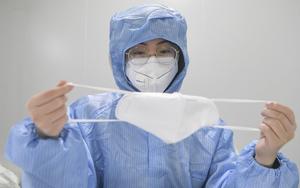 An employee checks N95 medical protective masks at a factory in Chongqing, Southwest China, on Feb 17, 2020. (PHOTO / XINHUA)
An employee checks N95 medical protective masks at a factory in Chongqing, Southwest China, on Feb 17, 2020. (PHOTO / XINHUA)
Due to a lack of melt-blown fabric, the face mask company that Gu Ning works for stopped production for five days on Wednesday.
The company in Changzhou, Jiangsu province, produces medical face masks that are exported overseas, mainly to East Asian countries such as Japan and South Korea.
"The price of melt-blown fabric has skyrocketed since the face mask market flourished with the emergence of the coronavirus," Gu said. "But the surging prices are not the problem; the quality is."
The price of melt-blown fabric, which was less than 20,000 yuan (US$2,820) per metric ton, had surged to 70,000 yuan and now sits at around 50,000 yuan. Many producers jumped into the market after the coronavirus spurred demand for the once obscure material.
"But much of the melt-blown fabric that they make cannot meet our standards," Gu said. "We cannot make qualified masks without high-quality melt-blown fabric. But now the good-quality fabric is all sold out."
"It left us no choice but to suspend production," he said. "We prefer suspension to producing masks with low-quality fabric."
The melt-blown fabric is a layer in the medical face mask that is made of polypropylene. The fabric is laminated by many interlaced fibers stretching in random directions.
Though the companies in Yangzhong produced about 70 metric tons of fabric a day, much of it could not pass quality checks due to inferior materials and subpar machinery used to produce it, according to the administration
Due to its structure, the fabric acts as the filter that stops pollutants such as particulates or bacteria from entering or exiting the mask.
To regulate the melt-blown fabric market, the Ministry of Public Security has cracked down on 20 melt-blown fabric-related cases and has arrested 42 people accused of fraud or price gouging related to fabric across the country as of mid-April.
Some suspects produced fake fabric using low-quality materials, while others sold genuine fabric at more than 10 times the regular price.
The local court in Shaoxing, Zhejiang province, recently ruled on its first fraud case involving melt-blown fabric. The court sentenced a man to one year behind bars and fined him 10,000 yuan.
READ MORE: Beijing responds to claims of China-made 'substandard' masks
Yangzhong, Jiangsu province, has suspended the production of all the melt-blown fabric companies in the city to regulate the market. Known as "hometown for melt-blown fabric", the city has 867 companies producing the material.
Almost all those companies were newly established, or had changed the scope of their businesses after the coronavirus outbreak, to enter the market, according to the Yangzhong Administration for Market Regulation.
Normally it takes at least three months and more than 10 million yuan to establish a factory that can produce quality melt-blown fabric.
Though the companies in Yangzhong produced about 70 metric tons of fabric a day, much of it could not pass quality checks due to inferior materials and subpar machinery used to produce it, according to the administration.
ALSO READ: Project shows faces behind the masks
Local police have detained some suspects who increased fabric prices for further investigation.
On April 13, Premier Li Keqiang said that the country will speed up international cooperation in controlling the outbreak of the coronavirus and that China will strictly monitor the quality of exported medical supplies.
He added that those who produce medical supplies without qualification, do not follow national standards and boost prices of medical supplies and their raw materials will be strictly punished.
Many large Chinese petrochemical, vehicle and home appliance producers have started to produce high-quality melt-blown fabric to meet the market demand. Starting this month, 20 new production lines of Sinopec Group and China National Petroleum Corporation have gone into operation.
Ma Zhenhuan contributed to this story.


